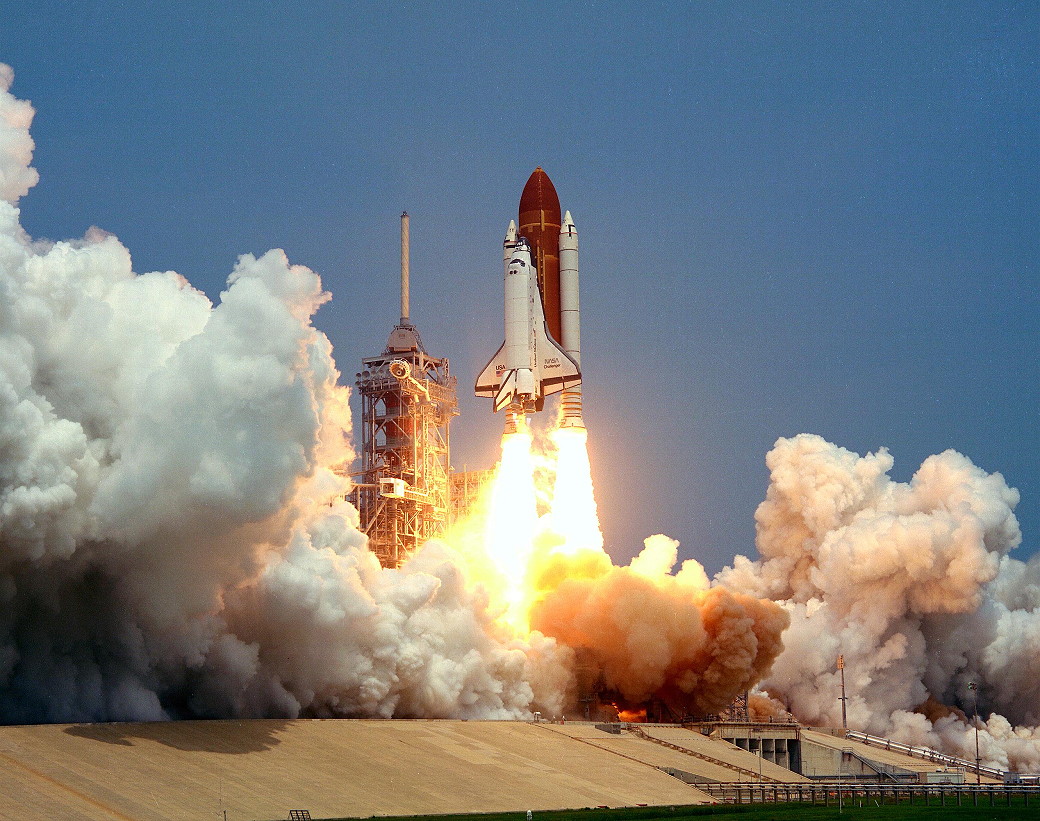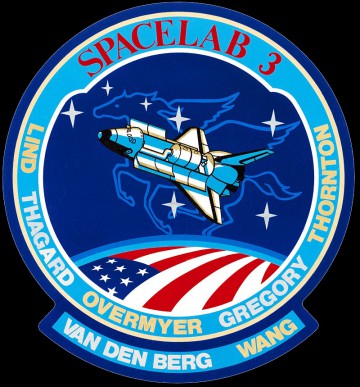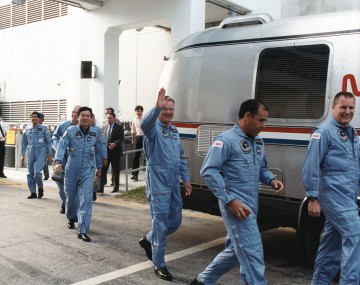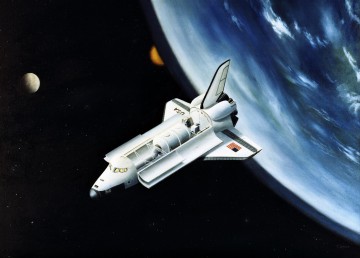
Challenger roars into orbit on 29 April 1985. Photo Credit: NASA, via Joachim Becker/SpaceFacts.de
Spacelab-3 was actually the second voyage of the joint U.S./European research facility, following the inaugural mission of the pressurized module aboard STS-9 in the fall of 1983. Spacelab-2 was intended to be a Verification Flight Test (VFT) of the unpressurized pallet and igloo combination, but had encountered technical difficulties with the Instrument Pointing System (IPS) and ended up being slipped until after Spacelab-3. Consequently, the module and a Multi-Purpose Experiment Support Structure (MPESS) were loaded into Challenger’s payload bay on 10 April, and the shuttle stack was transferred to Pad 39A at the Kennedy Space Center (KSC) just five days later. (In fact, only three days had elapsed since the launch of Mission 51D.)
During Mission 51B, Challenger would operate in a “gravity gradient” orbit, with her vertical stabilizer directed Earthward and her starboard wing pointing in the direction of travel, in order to ensure a stable microgravity environment and limit the amount of disruptive thruster firings. This would aid Spacelab-3’s vibration-sensitive materials science and fluid physics investigations. In readiness for the mission, the roof-mounted Scientific Window Adapter Assembly (SWAA) was removed and replaced by an aluminum panel, whereas the Scientific Airlock (SAL) was retained to house a French-built very-wide-field camera. Outside, the MPESS would accommodate the Atmospheric Trace Molecule Spectroscopy (ATMOS) and the Studies of the Ionization of Solar and Galactic Cosmic Ray Heavy Nuclei (“Ions”) experiments.

The patch for Mission 51B, emblazoned with the surnames of the seven-man crew. Image Credit: NASA
Spacelab-3’s primary focus was on microgravity research, specifically fluid physics and crystal growth, but an additional life sciences aspect evaluated how well the RAHF could support animals in an environment comparable to a ground-based vivarium. It had long been recognized that effective studies of primate or rodent behavior in space was impossible if their health and well-being were improperly maintained. In addition to water and food—rice-based bars for the rats, banana pellets for the monkeys—the RAHF supplied lighting, temperature, and humidity control functions. During the course of Mission 51B, Challenger’s crew were to work in two 12-hour shifts, with physicians Thagard and Thornton assigned to separate teams to keep watch the animals around-the-clock. NASA hoped to use the RAHF again for several rodent experiments on the Spacelab-4 life sciences mission, planned for launch in the spring of 1987.
Also under test was a Dynamic Environment Measuring System (DEMS) to record the acceleration, vibration, and noise in the cages during ascent and re-entry, and a Biotelemetry System (BTS) to transmit physiological data to the ground from a series of implanted sensors. “The squirrel monkeys adapted very quickly,” Lind told the NASA Oral History Project. “They had been on centrifuges and vibration tables, so they knew what the feeling of space was going to be like. Squirrel monkeys have a very long tail and if they get excited, they wrap the tail around themselves and hang onto the tip. If they get really excited, they chew on the end of their own tail. By the time we got into the laboratory, about three hours after liftoff, they were adjusted. They had, during liftoff, apparently chewed off a quarter of an inch of the end of their tails!” Both monkeys were free of various specified pathogens, and it was mandated that six months before launch they must also be free of antibodies to the Herpes saimiri virus. Although the virus was not known to cause disease in either squirrel monkey or human carriers, problems had been documented in other species and a global search found five Herpes saimiri-free primates. Due to time limitations, NASA only had the opportunity to prepare two of them for microgravity exposure and properly train them to reach the food pellets and activate the water taps in their cages.

The
crew of Mission 51B departs the Operations & Checkout (O&C)
Building on the morning of 29 April 1985. Photo Credit: NASA, via
Joachim Becker/SpaceFacts.de
In fact, van den Berg was internationally recognized as an authority on vapor-driven crystal growth. As the list of Spacelab-3 Payload Specialist candidates was drawn up, van den Berg and his chief at EG&G Corp., Dr. Harold Lamonds, could only come up with seven names, rather than the required eight. Lamonds told fifty-something van den Berg to volunteer, joking that his age, huge spectacles, and limited physical strength would probably cause him to be dropped in the first round of the selection process. It didn’t. Four candidates were eliminated by the initial screening for scientific competence. He was now down to the final four for a series of physical and mental tests, and he and metallurgical engineer Mary Helen Johnston passed with flying colors, whereas two others fell by the wayside due to possible heart issues. In June 1983, van den Berg and Johnston began training at JSC and in the fall of the following year, against all the odds, van den Berg was formally announced as the prime candidate.
If van den Berg’s ascent to a prime crew was rapid, then the opposite was the case for Don Lind, who had waited 19 years since his selection as an astronaut by NASA in April 1966. Having trained extensively for Skylab, he came within days of flying with Vance Brand on a daring rescue mission to America’s first space station in 1973, but wound up waiting longer than any other NASA-selected astronaut in history to reach actually space. It is a record that Lind still holds to this very day. When he was assigned to Spacelab-3 in February 1983, he expected to fly in September of the following year, but payload delays and shuttle manifest changes caused a slippage to November, then January 1985, and ultimately April, as well as switching orbiters from Challenger to Discovery, then back to Challenger again. With 54-year-old Lind, 53-year-old van den Berg, and 56-year-old Thornton aboard, this was the first U.S. piloted space mission to carry as many as three astronauts above the age of 50.

During
the majority of the seven-day mission, Challenger operated in a gravity
gradient orientation, with her vertical stabilizer directed Earthward
and her starboard wing pointing in the direction of travel. Image
Credit: NASA, via Joachim Becker/SpaceFacts.de
Challenger had scarcely an hour available in which to launch on 29 April 1985, with her “window” opening at noon EDT. This was calculated to provide the MPESS-mounted ATMOS instrument with the maximum number of viewing opportunities of the composition of the upper atmosphere during 72 orbital sunrises and sunsets. The ATMOS calibration and observations and a program for the French very-wide-field camera were “front-loaded” into the first day of the mission. Then, about 18 hours after liftoff, Overmyer and Gregory would reorient Challenger for almost six days in a gravity-gradient attitude to provide a suitably quiescent environment for the fluid physics and crystal growth investigations.
With the exception of a hydrogen leak in loading the External Tank (ET) with propellants, the countdown proceeded smoothly until 11:56 a.m. EDT, when, at T-4 minutes, a front-end launch processor failed and prevented the liquid oxygen replenishment valve and vent hood from closing automatically. The clock was held as the valves were manually repositioned and Challenger’s thunderous ascent at 12:02 p.m. was described by NASA as “nominal.”
However, it was not entirely nominal, because during the Rogers Investigation into the loss of Mission 51L in 1986, Bob Overmyer would discover exactly how close his crew came to death that day.